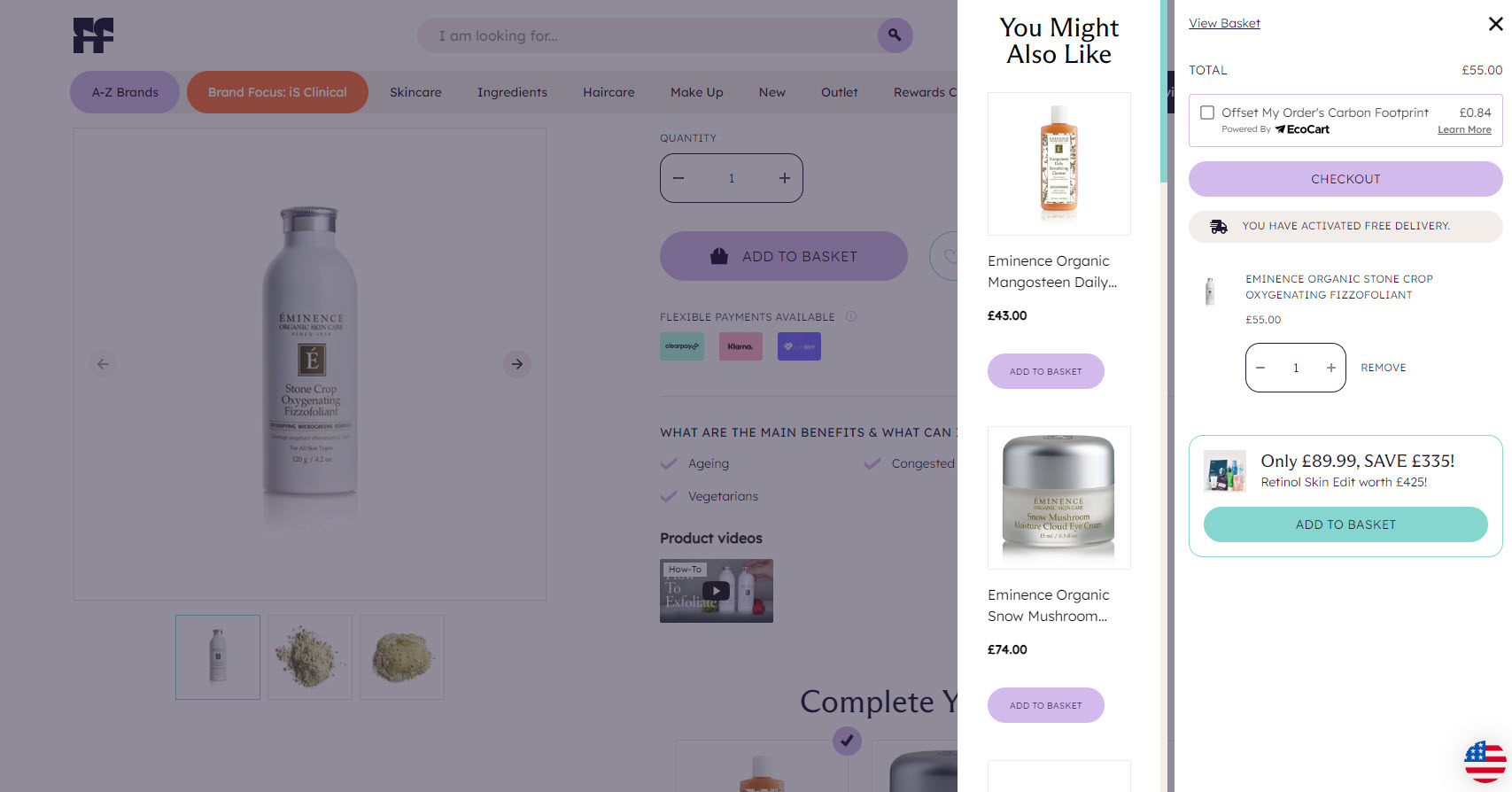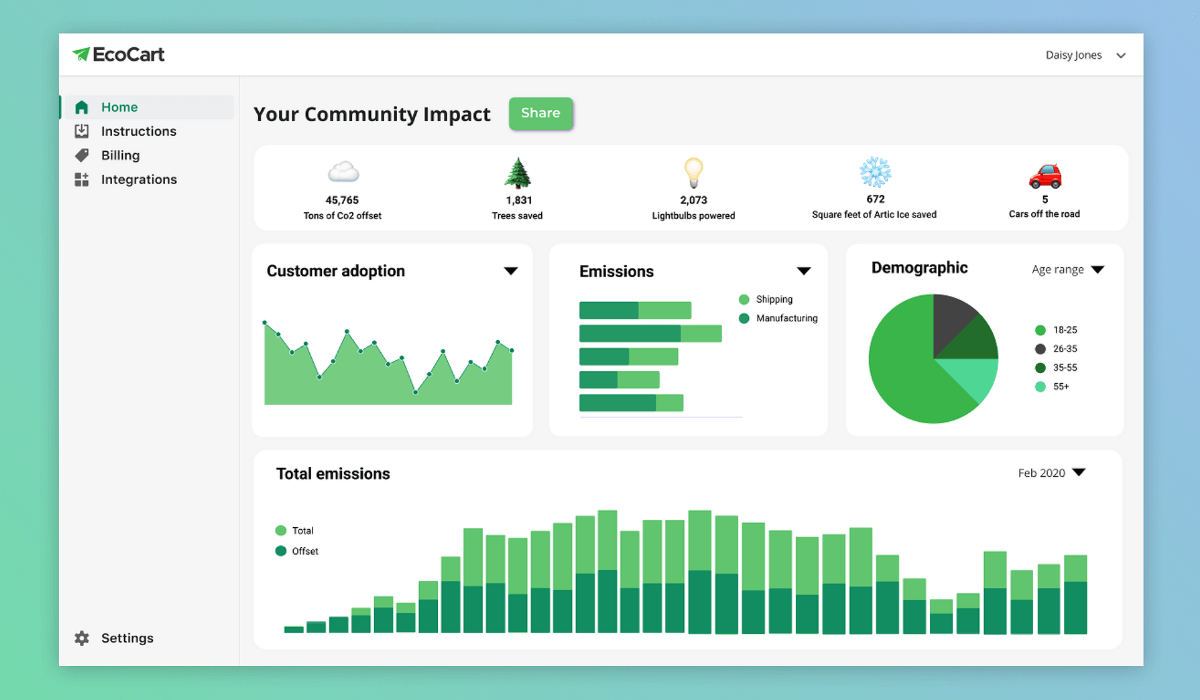In the shadow of emitting approximately 1.4 trillion tonnes of CO2 into our atmosphere over the last 270 years—half of which has been in the last few decades—it’s no surprise that environmental concerns are at the forefront of global conversations. This surge in emissions has led to some of the hottest years on record within the past decade alone, prompting a critical dialogue on eco-friendly practices and sustainability. Though often used interchangeably, these terms embody distinct concepts.
To clear up any confusion and navigate the nuances between sustainability and eco-friendliness, let’s explore what sets them apart.
Are Eco-Friendly and Sustainability The Same Thing?
While both concepts contribute to a healthier environment, there’s a slight difference between eco-friendly and sustainability in their approach and scope. Here’s a breakdown of sustainability vs eco-friendly:
- Eco-friendly is all about making choices that are kinder to the environment right now compared to their conventional or traditional counterparts. However, this doesn’t necessarily mean they are sustainable in the long run. Environmentally friendly initiatives take small, thoughtful steps to reduce harm but may not quite be the entire solution.
- Sustainability is a broader concept that includes eco-friendly initiatives but goes beyond them—it’s also about finding a balance between our social and economic needs and the environment’s ability to support us in the long run. And unlike environmentally friendly practices, sustainable initiatives aim not just to reduce harm but also to preserve resources and guarantee the planet’s long-term health.
What Does Sustainable Mean?
Sustainability is about adopting practices that protect and preserve the planet’s natural resources for the long haul. It’s not just about reducing emissions or recycling; it’s a holistic approach that involves making conscious choices in our daily lives—from the energy we consume to the products we purchase—to ensure that they have a minimal environmental impact. This concept encourages us to think about how our actions today will affect the ecological balance and the availability of resources for future generations, aiming for a world where economic growth and environmental stewardship go hand in hand.
However, it’s important to highlight that sustainability goes beyond the practice of resource management—it’s also about balancing social, environmental, and economic factors. These three main components, also referred to as people, planet, and prosperity, are known as the “Triple Bottom Line.” Let’s dive into each a little deeper:
People
Social sustainability promotes equity, justice, and well-being for all people, regardless of their background. These initiatives tackle poverty, inequality, and human rights to build strong, inclusive communities. This is a worthy cause, as an estimated 3.2 billion people are adversely affected by land degradation, highlighting the need for collective action to protect our ecosystems and maintain a healthy, inclusive society.
Planet
Environmental sustainability is dedicated to minimizing harm to our planet by preserving natural resources, ecosystems, and biodiversity, aiming for a healthy balanced ecology. This involves reducing waste, optimizing energy use, and safeguarding habitats to mitigate negative environmental impacts and ensure our environment remains vibrant and resilient. The urgency of this mission is underscored by the fact that the world’s population is consuming resources at a rate equivalent to 1.6 planets per year, a pace that is unsustainable in the long term.
Prosperity
Economic sustainability development seeks to foster stable and prosperous economies that harmonize with social and environmental policies, ensuring the well-being of both current and future generations. This approach includes advocating for fair trade, promoting responsible consumption, and achieving sustained financial growth that does not exhaust resources or harm the environment. Remarkably, the synergy between a healthy environment and economic prosperity is undeniable, with projections suggesting that transitioning to sustainable practices could yield savings of up to $26 trillion by 2030 through environmental developments and efficiency gains.
Sustainability’s impact extends beyond broad economic advantages to tangible benefits for individual businesses. For instance, having recently secured $14.5M in Series A funding, EcoCart stands as a prime example of how aligning with sustainable initiatives and responding to market demand for environmental responsibility can drive business success.
Download our FREE ebook:

What Does Eco-Friendly Mean?
Eco-friendly practices and products aim to reduce or, ideally, eliminate environmentally harmful impacts. In the realm of ecommerce, eco-friendly products are those designed with the utmost consideration for minimizing environmental harm. These products go beyond reducing resource consumption; they embody practices that aim to eliminate negative impacts on the environment throughout their lifecycle—from production to packaging, shipping, and eventual disposal.
For instance, an eco-friendly product might be made from recycled materials, require less energy to produce, and be shipped in packaging that’s both recyclable and biodegradable.
A prime example of eco-friendliness in action is the recycling of paper, which significantly alleviates the strain on our planet’s natural resources. This practice alone can save 3.3 cubic yards of landfill space, 17 trees, 682 gallons of oil, 4,100 kWh of energy, and 7,000 gallons of water for every ton of paper recycled. More than just conserving resources, it also reduces greenhouse gas emissions by 25 percent. In ecommerce, adopting eco-friendly practices means ensuring that products not only contribute to such savings but are also part of a larger effort to promote a sustainable and environmentally responsible consumer culture.
Here are a few examples of sustainable brands applying eco-friendly practices:

Are Eco-Friendly Products Sustainable?
Here’s the short and sweet answer: not always. Surprising, right? Sustainability encompasses more than just environmental harm reduction; it includes social and economic aspects vital to the planet’s health. Eco-friendly products, while beneficial, may not fulfill all criteria for sustainability.
While the concepts of eco-friendly and sustainability are simple enough to grasp, unfortunately, the terms are often too broad and ambiguous, often leading to greenwashing and sometimes other less-than-ethical practices—precisely why the Federal Trade Commission (FTC) has established guidelines for companies claiming to be eco-friendly.
The FTC’s Green Guides, as they are referred to, advise businesses to
- Avoid vague language and, instead, be clear and specific when qualifying general claims with environmental benefits.
- Provide solid evidence to support eco-friendly benefits like compostability, degradability, and non-toxicity.
- Disclose any potential conflicts of interest between a brand and certifying organizations.
- Be transparent about recycling facilities and recycled content in products.
- Specify the source of renewable energy used and avoid exaggerating its use.
- Clearly explain the use of renewable materials in products.
- Accurately represent source reduction claims to avoid deception.
While the FTC’s Green Guidelines exist for eco-friendly product claims, they are not enforceable. These guidelines are considered “administrative interpretations of the FTC Act as applied to environmental claims.” This means that a label of eco-friendliness doesn’t automatically ensure sustainability.
However, eco-friendly products play a crucial role in our journey towards sustainability. The global phase-out of chlorofluorocarbons (CFCs) in favor of eco-friendly alternatives like hydrochlorofluorocarbons (HCFCs) and hydrofluorocarbons (HFCs) has put us on track to heal the ozone layer by 2040. Yet, the transition to eco-friendly alternatives like HFC-134a, despite being less harmful to the ozone, presents a new challenge with a global warming potential 3,400 times that of carbon dioxide over a 20-year period.
This complexity underscores the importance of scrutinizing eco-friendly labels. While they may offer environmental benefits over their counterparts, assessing their contribution to a broader sustainability plan is essential for future generations.
Recent and Upcoming Sustainable Legislation:
- In California, AB 1305 aims to enhance transparency for purchasers of Voluntary Carbon Offsets (VCOs) by requiring disclosures from marketers and sellers. This legislation mandates significant public disclosures for entities in California making net zero, carbon neutrality, or emissions reduction claims, affecting both domestic and international sellers of any size operating in the state.
- AB 1305 requires these entities to disclose on their public websites how their “carbon neutral,” “net zero emission,” or similar claims are verified or achieved, including interim progress. This includes the disclosure of third-party verification of greenhouse gas emissions, science-based targets for emissions reduction pathways, and the sector methodology used.
- Similarly, the EU has updated its list of banned commercial practices to combat greenwashing and early obsolescence. New rules aim to protect consumers from misleading practices, including bans on unsubstantiated environmental claims and sustainability labels not based on approved certification schemes.
How To Know If You’re Shopping Sustainably
Consumer choices have significant influence. A striking 66 percent of Americans, and an even more impressive 80 percent of younger Americans (ages 18-34), are willing to invest more in sustainable products compared to their less eco-friendly alternatives. Although higher prices for environmentally sustainable products may not be within everyone’s reach, it’s noteworthy that such products often offer greater durability. This aspect serves as a compelling selling point for businesses, highlighting the benefits of longer product lifespans and, ultimately, a lower cost per use. This not only benefits the consumer’s budget but also has a positive impact on the environment.
Navigating the world of sustainable shopping can often feel like a maze, but there are clear markers to guide you towards making environmentally friendly and socially responsible choices. Here’s how you can identify and support these champions of sustainability:
Look for Certified B-Corps
Certified B-Corps stand out as beacons of social and environmental responsibility in the business world. These companies are subjected to stringent evaluations to ensure they meet the highest standards of social and environmental performance. For those eager to support businesses committed to sustainability, the B Corporation’s website is a treasure trove of information. It lists global leaders in the B-Corp community, allowing you to make purchases that align with your values.
By opting for Certified B-Corps and, when feasible, choosing sustainable options even at a higher price point, consumers clearly communicate to the market that environmental responsibility is crucial for a business’s success.
Investigate Production Processes and Materials
Understanding a product’s sustainability requires a deep dive into its origins and creation. This involves scrutinizing the production processes and materials used throughout the entire lifecycle of the product. Key considerations include the sourcing of raw materials, adherence to fair trade practices, and the product’s journey to reach you.
For instance, products made from virgin plastics, those shipped from far-flung locations, or manufactured under questionable labor conditions hardly exemplify sustainability or eco-friendliness. This highlights the importance of examining the environmental and social impacts of our purchases and seeking out sustainable products backed by credible verifications of their sustainability claims.
Through informed choices and collective action, we have the power to influence positive change for our planet and for the communities involved in the production of the goods we buy. Look for brands with a published sustainability statement that includes a life cycle analysis of products and business operations. Opt for products that use sustainable materials, meaning that they do the least damage on the natural environment and communities where the material is sourced.
Businesses interested in reducing their carbon footprint can use services like EcoCart’s Life Cycle Analysis to discover where the most emissions are produced in your supply chain. For any emissions you cannot eliminate, EcoCart’s Impact Projects can provide you with the opportunity to offset your emissions.
Want to know where your business stands? Get your sustainability scorecard with our quiz:
Offset Emissions Produced By Your Order
In an ideal world, every aspect of our shopping would leave zero carbon footprint. However, in reality, some emissions are inevitable due to manufacturing, shipping, and other logistical aspects of getting products (even sustainable products) to consumers. This is where the concept of offsetting carbon emissions comes into play, serving as a critical step towards achieving carbon neutrality.
Businesses are increasingly taking responsibility by implementing measures to reduce their emissions, but for those emissions that cannot be entirely eliminated, solutions like EcoCart’s carbon offsetting widget offer a viable path to sustainability.

EcoCart’s sustainable checkout widget integrates seamlessly into the shopping experience, allowing businesses to calculate the carbon footprint of each order and giving customers the option to offset these emissions at checkout.
This contribution goes towards EcoCart’s Impact Projects, which are carefully selected initiatives designed to have a measurable impact on the environment and communities around the world. These projects range from reforestation efforts to renewable energy installations, each contributing to the global fight against climate change.
By choosing to offset emissions through EcoCart, both businesses and consumers can take an active role in supporting sustainability and moving closer to a carbon-neutral world.
See EcoCart’s Case Studies to witness the sustainable checkout widget in action and the impressive growth these businesses experienced as a result.
Make Your Business Truly Sustainable
As an online business owner on the path to a more eco-friendly and sustainable future, taking proactive steps to understand and reduce the carbon dioxide emissions produced by your operations is crucial. EcoCart’s Life Cycle Analysis (LCA) tool empowers you to pinpoint precisely where in your product’s lifecycle the most emissions are generated, offering actionable insights to reduce your carbon footprint effectively.

Following this, integrating EcoCart’s checkout widget allows you to engage your customers directly in your sustainability efforts by enabling them to offset the emissions associated with their purchases. This not only showcases your commitment to environmental stewardship but also fosters a sense of shared responsibility with your customers.
This dual approach—first, actively reducing emissions where possible through informed changes in your operations, and then offsetting the unavoidable emissions—ensures a comprehensive strategy towards sustainability. By adopting EcoCart’s solutions, you’re not just minimizing your business’s environmental impact; you’re also leading by example and contributing to a broader movement towards a sustainable future.
Request a demo today to see how EcoCart can facilitate your business’s journey towards becoming truly sustainable, ensuring that every transaction makes a positive contribution to our planet.



